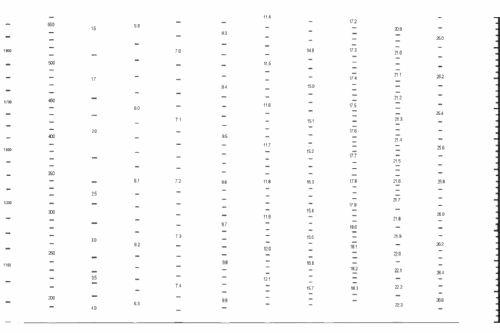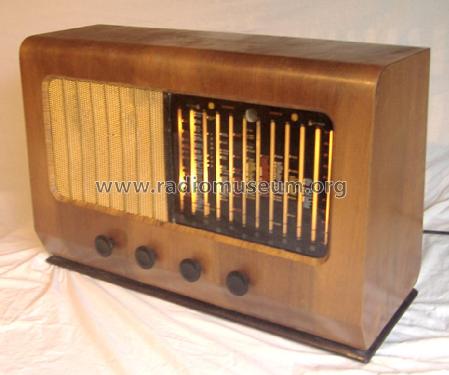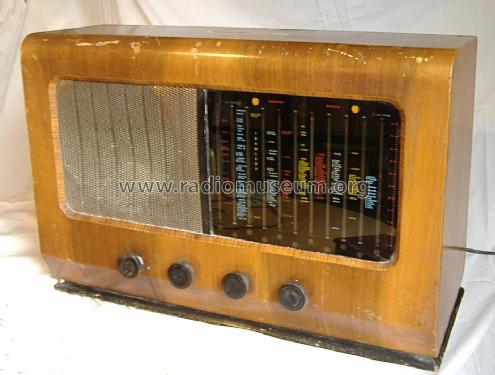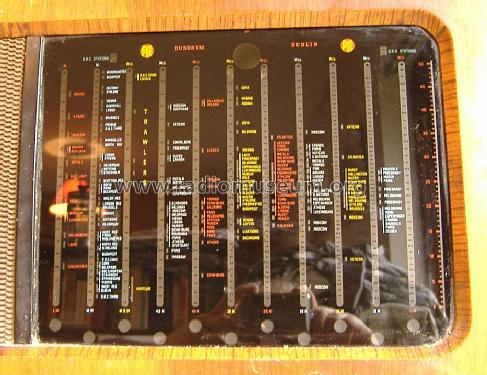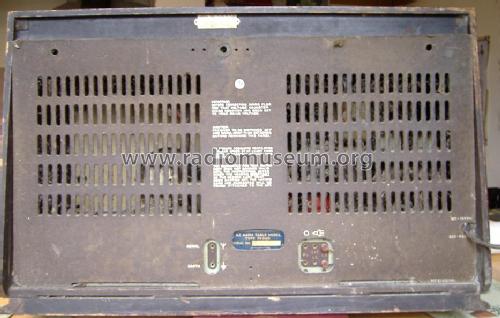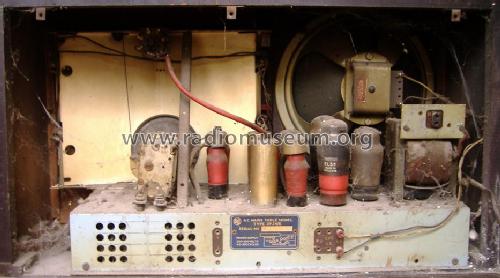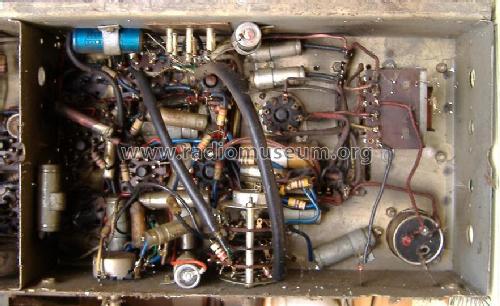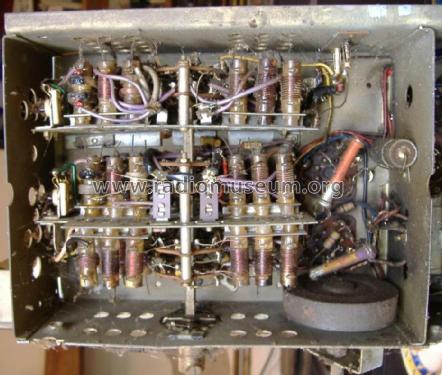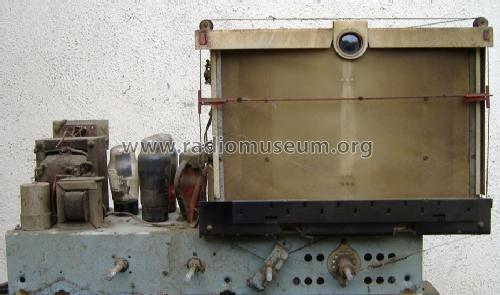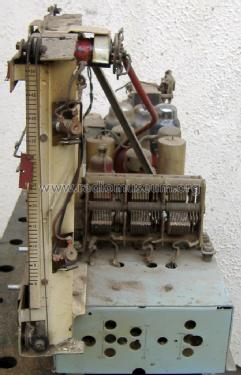- Country
- Ireland
- Manufacturer / Brand
- Pye (Ireland) Ltd.; Dundrum, Dublin
- Year
- 1949 ??
- Category
- Broadcast Receiver - or past WW2 Tuner
- Radiomuseum.org ID
- 206844
Click on the schematic thumbnail to request the schematic as a free document.
- Number of Tubes
- 9
- Main principle
- Superhet with RF-stage; ZF/IF 465 kHz; 3 AF stage(s)
- Tuned circuits
- 7 AM circuit(s)
- Wave bands
- Broadcast, Long Wave and more than two Short Wave bands.
- Power type and voltage
- Alternating Current supply (AC) / 100-150; 200-250 Volt
- Loudspeaker
- Permanent Magnet Dynamic (PDyn) Loudspeaker (moving coil) / Ø 10 inch = 25.4 cm
- Power out
- 14 W (unknown quality)
- Material
- Wooden case
- from Radiomuseum.org
- Model: 39 JH/E - Pye Ireland Ltd.; Dundrum,
- Shape
- Tablemodel, low profile (big size).
- Dimensions (WHD)
- 650 x 440 x 250 mm / 25.6 x 17.3 x 9.8 inch
- Notes
- 11 bands (9 SW bandspread): LW, MW, MSW/Trawler (1.4 - 4.0 MHz), SW; 49 metre, 41 metre, 31 metre, 25 metre, 19 metre, 16 metre, 13 metre and 11 metre. Four 6.3V dial bulbs. Push-pull audio output (EL33 x 2) using EBC33 as phase splitter (diodes unused on 2nd EBC33). EF39 RF pre-amp, so triple section variable capacitor (two sets according to band). On/Off switch has 4x radio tone settings and 2x "gram" tone settings, thus is off/radio/gram 7 way switch. Waveband switch has wire drive to a shutter with 11 slots to indicate which band is selected by allowing light from dial lamps onto clear circles on tuning scale glass. See also similar models 1949 PYE 39J/H, 1950 PYE A39J/H model and export model PYE PE41 (no LW and cloth speaker cover). Case and speaker without chassis weigh 8kg. Gold/Brass anodized "expanded" Aluminium speaker grill. Scale has DUNDRUM and DUBLIN between the two PYE logos at the top. Magic Eye is behind top centre of tuning scale glass. No Internal rod or loop aerial Requires external wire, though only a few metres is needed to operate LW. Differences from UK PYE 39J/H: 1) Cabinet shape slightly different with single large cut-out for speaker grill and dial glass. 2) Expanded mesh Aluminium speaker grill 3) Addition of EM34 with bracket and cut-out on dial chassis, clear circle in dial glass paint and U cutout on lamp diffuser. Some addition switch wiring and at least one resistor and capacitor. Otherwise appears to be identical chassis to 1949 PYE 39J/H. 4) The UK 39J/H has 5th indicator bulb not present on 39JH/E, presumably dropped as there is a magic eye. The Magic eye is extinguished on the two "gram" positions. the two diodes on one of the EBC33 are unused and not connected at valve base. The mains transformer has 3 way voltage plug accessible at rear and soldered wires to select 100 ... 150 or 200 ... 250V operation. The 14W audio power estimated assuming Class AB. Ia is 26mA per EL33 with about 275V Anode volts. This seems reasonable given EL33 data and sheer volume experienced. There is negative feedback from loudspeaker connections. Internal speaker on flying lead to rear socket,external speaker, gram aerial/earth all wnder plugs. Probably produced at Pye Factory near Dundrum/Kilmacud, Dublin, Ireland.
- Net weight (2.2 lb = 1 kg)
- 18.2 kg / 40 lb 1.4 oz (40.088 lb)
- Mentioned in
- Radio Servicing page 274
- Author
- Model page created by Michael Watterson. See "Data change" for further contributors.
- Other Models
-
Here you find 18 models, 17 with images and 5 with schematics for wireless sets etc. In French: TSF for Télégraphie sans fil.
All listed radios etc. from Pye (Ireland) Ltd.; Dundrum, Dublin
Forum contributions about this model: Pye Ireland Ltd.;: 39 JH/E
Threads: 3 | Posts: 5
The numbers tend to "fall off" the scales on this family of radio sets. The Service information has a card for setting on the rear dial plate when radio chassis is out of case getting aligned.
I scanned this and adjusted column spacing to match the glass dial plate. Then on a different layer typed the numbers to get better quality and correct size.
(See "Schematic Section of Model", The actual schematic is same as 39J/H except for magic Eye which is like PE80 schematic.)
The image is 265 x 177 mm (print 100%) and printed on A4 laser transparency film, normal way round.
The film is trimmed (including removal of the log scale which verifies correct height) and affixed to the rear of glass with masking tape. The numbers look like they are printed on the glass.
If you need a colour scale and don't have a colour laser printer (Ink jet printing on film is too transparent) then print on photo paper and get colour photocopied on to Letter, A4 or Legal (14") Transparency film.
If you need gold or white, then print in Black Laser (or black photo copier) and use a laminator with white, silver or gold heat transfer foil. It only sticks to the black. You could then have three layers of transparent film behind clear glass (holes here cost about €3.50 each). If the layout is suitable you can cut paper mask for heat transfer foil and use only one or two layers of film. Laser print or photocopy the colour first and then Black on Mono Laser or copier and cut paper mask as the heat transfer foil doesn't work well with "black" from a Colour copier or Colour Laser. An Inkjet is only good for Mono or Colour for use with a Colour or mono photocopier that uses toner.
Michael Watterson, 30.Jan.12
There is no frame, rod or loop aerial. However even on Longwave in Limerick Ireland the French stations and UK R4 are audiable on only 3m of wire indoors.
Would people have used a Picture Frame concealed loop aerial, random wire on picture rail or outdoor aerial and earth?
Michael Watterson, 20.Nov.11
The PYE 39 J/H is similar chassis, different style on case. The schematic of the 39 J/H seems accurate apart from the EM34 magic eye circuit which all three similar UK models lack.
It's possible this model was only made in Pye's Irish Dundrum factory (then on edge of Dublin) and only for Irish market.
Michael Watterson, 20.Nov.11
